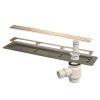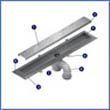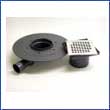 |
 |
 |
 |
| Wet Room Kits |
Wet Room Kits |
Wet Room Drains |
Wet Room Shower Channels |
| by Novellini |
by ACO |
by Wirquin |
by Wirquin |
How to Wet Room - A Guide for the Wet Room Novice
With the ever-growing popularity of wet rooms, it’s becoming easier and easier to install these functional and stylish additions to your home. With the work involved, however, wet room installation can initially be a daunting journey to embark upon. To help the first-time installer along, we have put together this guide – ‘How to Wet Room’.
How to Wet Room Question 1:
What is a wet room?
A wet room is essentially a shower room that is completely open, tiled and waterproofed. It does not usually include a shower tray or screen, but a screen can be installed if your bathroom is not large enough to include a completely separate wet room space.
How to Wet Room Question 2:
What are some of the advantages of a wet room?
- Luxurious – As wet rooms are separate to the main bathroom, they offer the luxury of space and an entirely new showering experience.
- Practical – Doing away with the cumbersome shower tray of yore, tiled wet rooms are easier to keep clean.
- Durable – Because the wet room is completely waterproof, floor protection is better than with a traditional shower and tray (as long as it has been installed correctly).
- Beautiful – Contemporary, stylish, spacious. Wet rooms look great!
- A Wise Investment – Wet rooms are so sought-after that they can increase the value of your home. However, if it is used to replace the main bath, it can actually have the opposite effect.
How to Wet Room Question 3:
What are the disadvantages of a wet room?
- Can impact negatively on the sale of your house – If a wet room is installed in the place of an actual bath, it can affect the saleability of your house. Most people still expect a house to have a main bath.
- Not suitable for very small rooms – Wet rooms are becoming more and more of an achievable reality for many. However, if your bathroom is very small, due to overspray from the shower head, a wet room may not be a feasible option.
- Can be difficult to install – Our wet room kits make installing a wet room as painless as possible. However, we still recommend that the job is completed by an experienced professional to ensure that your wet room gives you many years of enjoyment.
- More expensive – At Midland Bathroom Distributors, we have years of experience and buying power, which translates into the cheapest possible prices for our customers. However, wet rooms do need to be tiled from floor to ceiling, and inevitably this makes them more expensive than a traditional shower setup.
How to Wet Room Question 4:
How do I ensure adequate water drainage in my wet room?
Traditional shower trays are much like large bathroom or kitchen basins – they are curved so that water is diverted down into a waste hole. Wet Rooms are similar, but rather than being curved, the floor is installed at a very slight, almost unnoticeable gradient, allowing the water to run down into a waste grid.
The easiest method to create this gradient is to use a ‘deck’ or wet room tray. This is a prefabricated graduated floor that can be slotted into an existing floor surface. Our wet room kits come with this deck, as well as a drain by Aco – market leaders in drainage systems.
How to Wet Room Question 5:
How do I make sure that my wet room is waterproof?
It is very important to make sure that your wet room area is completely ‘tanked’ or waterproofed. Waterproofing involves first priming the floor, covering the floor and a small way up the walls with a special bitumous membrane, and then testing the floor for its ability to hold water before tiling.
It may sound complicated, but thankfully our wet room kits come with an optional waterproofing kit to make this most essential of jobs an absolute breeze.
How to Wet Room Question 6:
What tiles should I use, and do they need to be heated?
To avoid potentially dangerous slippery surfaces, we recommend that you choose non-porous bathroom floor tiles which ensure a good grip on wet floors. Other than that, you’re only limited by your imagination!
Underfloor heating can also be advantageous, as it will help the floor to dry quickly and also – importantly! – keep your bare feet warm in winter.
|